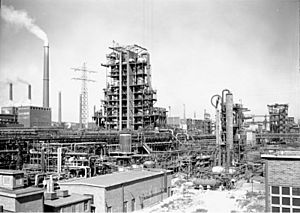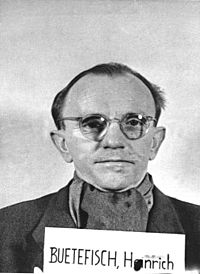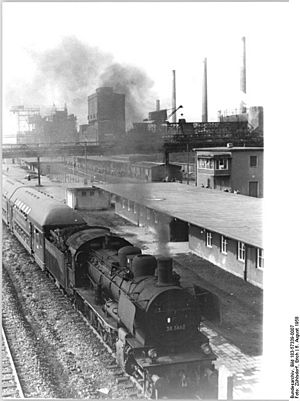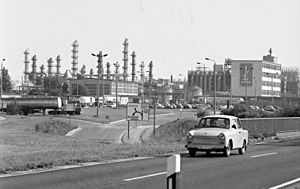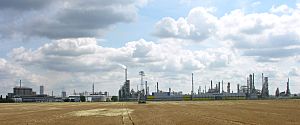Leuna works facts for kids
The Leuna works (called Leunawerke in German) is one of the largest chemical factories in Germany. It is located in Leuna, Saxony-Anhalt. Today, big companies like TotalEnergies, BASF, Linde plc, and DOMO Group own parts of the site. This huge area, covering 13 square kilometers, makes many different chemicals and plastics.
Contents
How the Leuna Works Began
Ammonia is a very important chemical. It is used to make nitric acid and other nitrogen compounds. These are needed for making fertilizers (to help plants grow) and explosives. During World War I, there was a huge need for explosives. The existing factory in Oppau (owned by BASF) could not make enough ammonia.
So, Leuna was chosen for a new factory. It was far from French aircraft, making it a safer place. Construction started on May 25, 1916. The first tank car full of ammonia left the factory in April 1917.
In 1920, the ammonia factories in Leuna and Oppau joined together.
The Leuna site was also close to lignite (brown coal) mines. This was good because lignite could be used to make syngas (a mix of hydrogen and carbon monoxide). Scientists also tested how to turn coal into liquid fuels on a large scale here. The Leuna plant began making liquid fuels from lignite on April 1, 1927.
In the late 1920s and 1930s, the Leuna site grew quickly. It started making methanol, synthetic petrol (gasoline) from lignite, and detergents. Making synthetic petrol was expensive. However, Germany wanted to rely less on imported oil. By 1939, seven plants in Germany were making synthetic petrol, and Leuna was the biggest.
In 1936, work began on the Buna Werke Schkopau plant. This factory, which made synthetic rubber, was a part of the Leuna ammonia works at first.
Leuna During World War II
The Leuna works was one of the largest factories making synthetic oil in Nazi Germany. It was also the second biggest chemical factory. Because of this, it became a main target for Allied bombing attacks during World War II. These attacks aimed to stop Germany from producing oil.
The Leuna plant covered about 3 square miles (8 square kilometers). It had 250 buildings and employed 35,000 workers. This included 10,000 prisoners and people forced to work. The factory was heavily defended. There were 28,000 soldiers and many other helpers protecting it. They had over 600 radar-guided guns. The air raid protection team had more than 19,000 workers.
Bombers attacked Leuna 22 times, dropping over 18,000 tons of bombs. Leuna was the most protected industrial target in Europe. It became so dark from anti-aircraft fire and smoke that pilots often could not see where their bombs landed. Only a small percentage of bombs actually hit the plant.
Despite the strong defenses, the attacks were important. They made it very hard for Germany to get the fuel and other supplies it needed for the war. On April 4, 1945, production at Leuna stopped completely.
Leuna from 1945 to 1990
After World War II, parts of the Leuna works were destroyed. About half of the remaining machines were taken by the Soviet Union as war payments. In the years that followed, the Leuna site was slowly rebuilt and made bigger.
In 1954, the factory became public property. It was named "VEB Leuna-Werke Walter Ulbricht". It became the largest chemical production site in East Germany. A new, modern plant called Leuna II began construction in 1959. This plant focused on petrochemistry, which uses oil to make chemicals. It had equipment to produce ethylene and propene, which are used to make things like phenol and plastics.
An oil refinery was also built in the 1950s. It processed crude oil that came from the Soviet Union through a pipeline. This allowed Leuna to make gasoline, diesel, and heating oil. These fuels were even sold outside East Germany to earn money.
The Leuna works employed about 30,000 people. The factory complex was about 7 kilometers long and 3 kilometers wide. It had its own railway stations and tram stops.
By the 1980s, some of the older parts of the factory were very old (up to 70 years). They cost a lot of money and energy to run, making them less profitable.
Leuna Since 1990
After Germany reunited in 1990, the Leuna works was split into many smaller parts. These parts were sold to different companies, including Total S.A., BASF, Linde AG, and DOMO Group. A company called InfraLeuna now provides common services for all these businesses.
Many older, less profitable parts of the factory were closed. The site was also modernized. Because of these changes, the number of employees went down a lot, from 28,000 in 1978 to 9,000 in 2014.
In the early 1990s, the Leuna oil refinery was transferred to a French company called Elf Aquitaine (which later became part of Total). In 1997, a new, modern refinery called MIDER (now TRM) started making products. This was a very large investment by a French company in eastern Germany. The European Union also provided financial help for its construction. The industrial complex has grown even more with new plants built in an area called Leuna III.


